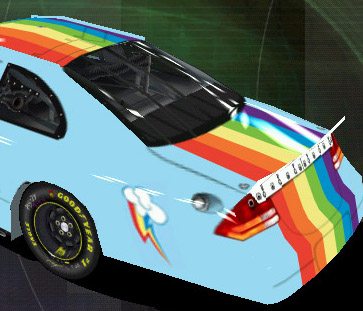The penthouse where NASCAR was founded in 1947 is now a gay bar.
Back then, Bill France Sr. walked into the four-story, art deco Streamline Hotel and, in a series of meetings, laid out the rules and regulations of what would become the nation’s most popular racing organization.
Friday, two days before the 54th running of France’s baby, the Daytona 500, the lobby of that same hotel, now dusty and worn, was filled with a combination of cheap NASCAR memorabilia and a line of drag queens set to sing and shake to a raucous crowd of almost exclusively male patrons gathered inside the hotel’s racing-themed bar.
It’s a mix of grandiosity, color and humor right here in the birthplace of a sport that has thrived on packaging the exact same cocktail. If Bill France Sr. had ever decided to create a gay bar, this would be it: comfortable, inclusive and with beer sponsorships on every inch of the wall.
Yes, there in a room with a checkered-flag ceiling, the hood of a Busch Series car on the wall and a neon Miller Lite rainbow Pride sign glowing above, Kelly Mitchell and her crew were right at home.
What, this is more flamboyant than neon-green race cars? Wilder than those makeshift clubs in the infield of Daytona International Speedway?
My favorite driver? stage performer Kelly Mitchell said. How about Madonna.
An old police chief once called the Streamline a den of iniquity, which the regulars took as a badge of honor. Developers have proposed buying the place, renovating it and turning it into a spiffed-up, NASCAR-themed museum and hotel.
Somewhere in between lies the Streamline’s present reality: an aging joint with more personality than customers ($89 rooms available even on race weekend).
Where else could you purchase a Kurt Busch vintage die-cast car for $44.95 while listening to a husky drag queen belt out Shania Twain’s Man, I feel like a woman?
The Straight Story
In December 1947, Bill France Sr. gathered a group of racing enthusiasts in the rooftop lounge, now the Penthouse Club. It remains the city’s best perch, with crashing waves just a block to the east and the lights of the famed Daytona International Speedway, France’s ultimate legacy, glowing six miles to the west.
Back then, France was trying to bring order to a sport that traced its roots back to the bootleggers flying over the dirt roads of the South during prohibition. He emerged with NASCAR but never turned his back on the outlaw nature of the sport “ a populist, live-and-let-live (just live it fast) persona. What other major professional sport was born in a bar anyway?
Bill France Jr. came here with the mayor and dedicated the plaque outside [marking the hotel’s place in NASCAR history], hotel manager Michael Blake said. They had no problem and they knew what business was happening here.
NASCAR is a far more progressive company than its stereotype. It’s taken strong stances against the flying of the Confederate flag, engaged in outreach programs to inner cities and been home to tremendous professional opportunity for women “ not just as drivers but team owners, executives, marketers and publicists.
And while its fan base is often categorized as solely Southern, rural and working class, the infield rows of tricked-out motor homes with Northern license plates and price tags pushing $400,000 tell a different story.
Perhaps it’s why Blake says NASCAR fans generally range from indifferent to supportive of the Streamline. Whether it’s in the expansive infield or here near the beach, this is a group that’s often looking to raise a little hell before watching a little racing. The love of a fast car can sometimes cut through barriers.
